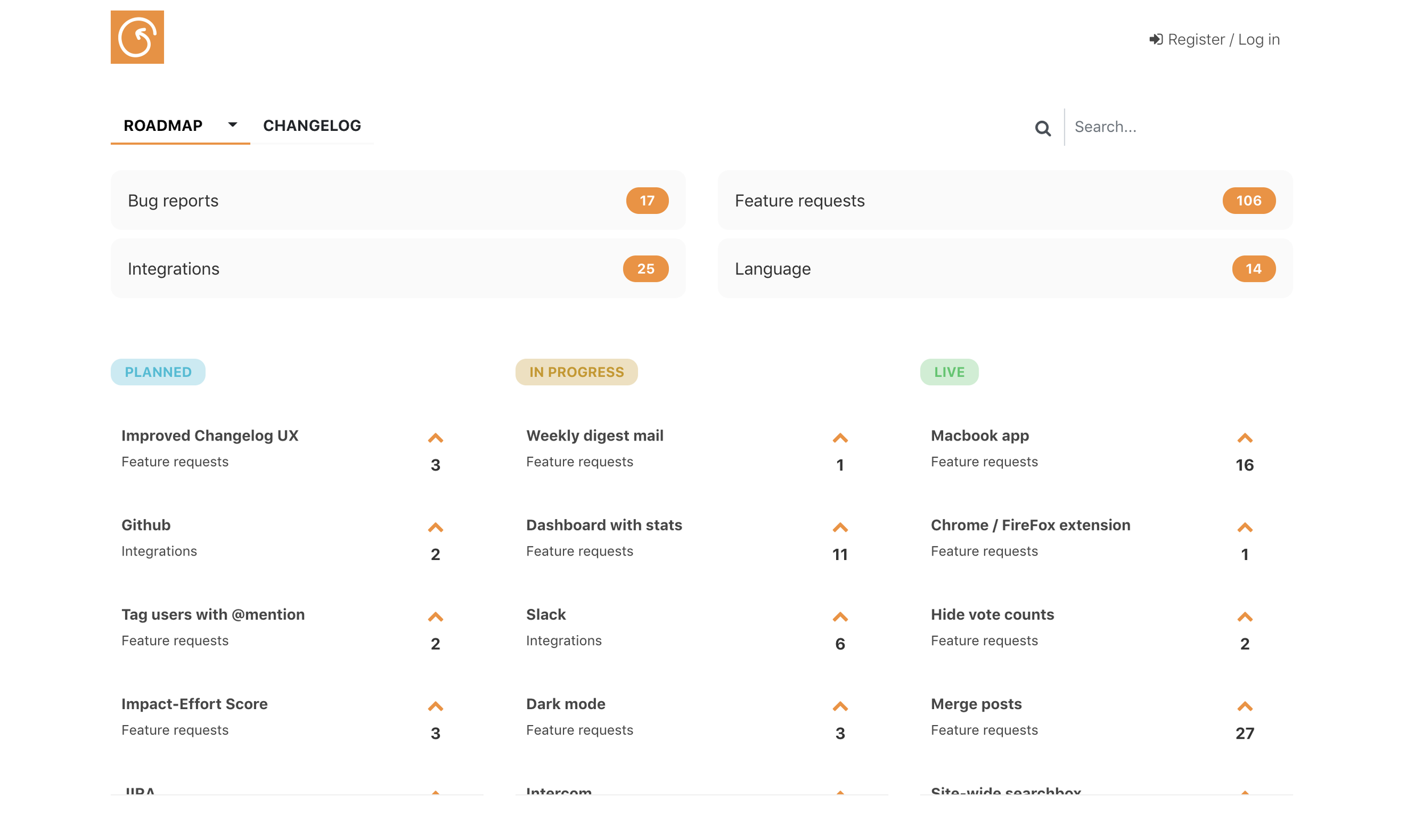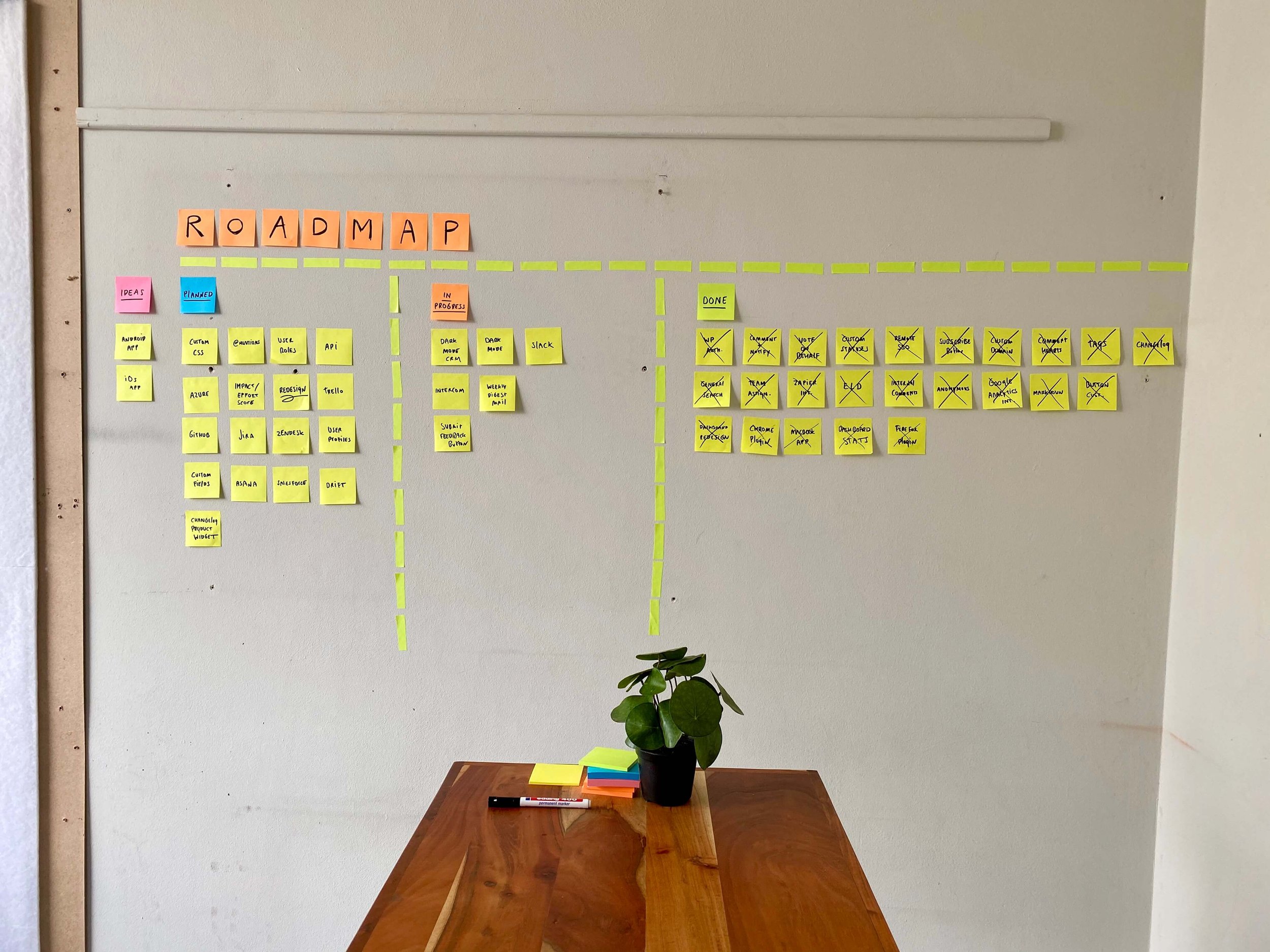How to Create Your First Product Roadmap
You can’t run your SaaS business without a product roadmap. After all, you wouldn’t visit a new city without a map, would you? It will take you much longer to find your way without having one. Plus, you won’t be able to schedule your day efficiently and take advantage of your travel.The same is true for your SaaS company. Without a product roadmap, you’ll miss direction and lack the necessary vision to coordinate your team’s efforts.But let’s take it one step at a time and answer the main question.
What’s a product roadmap?
A product roadmap is a framework that includes the steps you’ll take to continue developing and improving your product. It’s a plan that helps you clearly articulate your product’s vision and decide what actions your team must take to execute the strategy.As ProductPlan highlights, “A product roadmap is a high-level visual summary that maps out the vision and direction of your product offering over time.” Not having a product roadmap will expose you to multiple risks, as we’ve detailed below.
Risk 1. Lack of direction
As you probably already know, your product is alive. You can’t build something and think that it will work for years without any improvement or development. This is not how you gain and retain customers. Building a vision, strategy, and direction for your product is mandatory if you want to survive as a business. But you can’t do that without a product roadmap.
Risk 2. Not having clear OKRs (objectives and key results)
A roadmap is crucial for aligning your product’s future development with your business goals. By envisioning the direction you want to take, you’ll be able to come up with realistic OKRs and make sure you’re hitting your quarterly and annual objectives. Not having a product roadmap, though, will lead to weak goals and business stagnation.
Risk 3. Inefficient team communication
The worst thing you can do to your SaaS business is not communicating with your team(s). But how do you expect to communicate with your engineers efficiently if you can’t provide them a clear roadmap that will show them what they should focus on next? Moreover, without a product roadmap, your team won’t be able to track their progress. This will lead to disorganized communication, which will transform into a messy product.
Risk 4. Zero prioritization
What tasks waste most of your team’s time without driving a significant impact on your business? On the other hand, what tasks will actually move the needle for your company that your engineers aren’t working on? Without a product roadmap, you’ll be unable to answer these questions. You’ll lack prioritization and run the risk of wasting time on less important assignments that won’t do much in terms of revenue or customer satisfaction.
Risk 5. No consensus
Product roadmaps are the result of strategic conversations and consensus between teams. You can’t design one without agreeing upon the essential things that need to be executed. That being said, without a product roadmap, there won’t be a consensus between teams, and each one will have their own vision about your product’s direction. Is there anything more disastrous than that?
Risk 6. Inefficient use of customer feedback
How will you incorporate your customer feedback into your product development plan without a roadmap? Will you just say yes to all of your customer requests and overwhelm your team with actions that lack strategy? This won’t do anything other than generating chaos, anxiety, and stress among your engineers.
Risk 7. Lack of transparency with your stakeholders
Did you think about your investors? And how about your paying customers? How will you communicate your product’s vision and direction with them? Without a product roadmap, you won’t have any transparency or be able to build a long-lasting, trust-based relationship with your external stakeholders.As you can see, it’s impossible to build a sustainable and successful SaaS business without a clear direction. That being said, let’s continue with the steps you’ll want to take to create your product roadmap. But first, let’s see what tools you can use to design one and share it with your team.
Basic tools to create your first product roadmap
Don’t overcomplicate your product roadmap, especially if you’re just beginning. We recommend you start using free tools you can find online, or, use your wall (like we still do in our office!). If you don't want to mess up your walls, you can use Google Documents, for example. It may take some time to come up with a framework and configure the Google spreadsheet, but Google Documents are easy to edit and share. Plus, they’re awesome when it comes to collaborative projects.Another tool you can use is coda.io. Although it’s a freemium product, you can use it to create product roadmaps, share them with your team, and collaborate together on editing it. Moreover, Coda offers a strong product roadmap template you can use and adapt immediately.Now let’s discuss the steps you’ll want to take to design your first product roadmap and make sure it’s both robust and results-driven.
If you don't want to mess up your walls, you can use Google Documents, for example. It may take some time to come up with a framework and configure the Google spreadsheet, but Google Documents are easy to edit and share. Plus, they’re awesome when it comes to collaborative projects.Another tool you can use is coda.io. Although it’s a freemium product, you can use it to create product roadmaps, share them with your team, and collaborate together on editing it. Moreover, Coda offers a strong product roadmap template you can use and adapt immediately.Now let’s discuss the steps you’ll want to take to design your first product roadmap and make sure it’s both robust and results-driven.
Step 1. Design a product strategy
You can’t just make up a product roadmap out of your head—you need a clear business and product strategy first. While a roadmap communicates the steps you’ll take to develop your product, a strategy outlines the end goal of your product and how it will sustain your entire business.As ProductPlan notes, “A product strategy is a high-level plan describing what a business hopes to accomplish with its product, and how it plans to do so. This strategy should answer key questions such as who the product will serve (personas), how it will benefit those personas, and what are the company’s goals for the product throughout its lifecycle.”To design a product strategy, identify your ICP (ideal customer profile), outline the problems your product will solve, determine your value proposition, define your market positioning, and know your key product differentiators. This will provide you with the foundation for a strong product roadmap that corresponds with your business goals.
Step 2. Choose a features prioritization framework
There’s no shortage of ways in which you could be mapping your product’s development. For example, there’s the value-complexity matrix, based on “categorizing potential new features by their expected business value and implementation complexity.”In other words, it refers to evaluating the work and effort your team will need to put into developing a new feature, for example, and the value you’ll be able to capture afterward. In this case, you’ll have a matrix with four quadrants crossing concepts such as high value and low value and high complexity and low complexity.You may want to spend time on those tasks that are of high value and high complexity. And on the other hand, you may want to delay those tasks that are of high complexity, yet low value.Another prioritization framework is the Kano model. This one involves a simple, two-axis grid based on comparing the investment needs to implement the features and their potential to satisfy customers.In this case, there are:
- Basic features, which won’t get people too excited, yet these features are needed
- Performance features, which will increase customer satisfaction
- Excitement features, which will make people talk about your product
Your responsibility, in this case, will be to evaluate which features to prioritize, along with the investment you need to make.But regardless of which features prioritization framework you choose (and there are many!), make sure the matrix is aligned with your priorities, business goals, and how your team works.
Step 3. Analyze the costs, time, and value of each item
Each item you include in your product roadmap requires time and effort, and not all of them will provide you with equal results in terms of customer satisfaction or differentiation. So evaluate carefully what each item involves. You can do that by talking to your team and analyzing the user feedback you’re gathering.
Step 4. Consider the end results your clients want to achieve
Adding a cool feature or item may be exciting, but it’s not always aligned with your clients’ goals. So make sure you know what problems your main target has and what steps you need to take to equip them with the right features. Then, make sure to prioritize these items when building your product roadmap.
Step 5. Make space to include relevant user feedback
Customers will always be vocal about the features they want you to improve or include in the product. And obviously, these requests won’t always match your product strategy or goals. However, it’s important to include space for your customers’ feedback and requests, as well as fixing bugs and adding the features most of the people want to see and use. By doing so, you’ll show your customers how much you care about their experience, and you’ll continue having an efficient dialogue with them.
Step 6. Be realistic in terms of deadlines
The planning fallacy is something we all suffer from. We all think it will take us less time to accomplish something than it really does. That’s why you should always add an additional week or two to what you initially estimated for each item into your product roadmap. This gives you a more realistic view of your deadlines, plus you won’t be putting too much pressure on your engineers.
Bonus step
Create a physical representation of the product roadmap. Building and sharing a product roadmap online is great in terms of agility, but there’s nothing more powerful than a physical reminder and be able to visualize it easily.We recommend putting up a poster or picture of your product roadmap in the office for everyone to see. Also, create three categories—To-Do, In Progress, and Completed—and assign Post-It notes for each item or feature you want to include in your product. Then put them all on the wall. Soon, you’ll discover that there’s nothing more satisfying than to see all those Post-It notes moving from “To-Do” to “Completed.”
Let’s recap
Your first product roadmap shouldn’t be fancy or sophisticated.
- Start by designing a strong product strategy that is aligned with your resources, business goals, and ICP’s needs.
- Choose the feature prioritization framework that works best for your team.
- Make sure to find a way of evaluating both the resources and impact each product roadmap item involves
- Don’t forget to be always aware of the goals your customers want to achieve.
- Finally, always include relevant user feedback into your roadmap (use Upvoty!) and be realistic with the deadlines.
? Don’t pressure your engineers too much, and don’t promise overnight miracles. Building a strong product takes time and effort, so be prepared for a long marathon.

